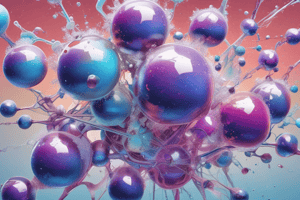Podcast
Questions and Answers
What is the key difference between a homogeneous mixture and a heterogeneous mixture?
What is the key difference between a homogeneous mixture and a heterogeneous mixture?
- Homogeneous mixtures are solutions, while heterogeneous mixtures are suspensions.
- Homogeneous mixtures have distinct phases, while heterogeneous mixtures have a uniform appearance.
- Homogeneous mixtures are reversible, while heterogeneous mixtures are not.
- Homogeneous mixtures have a uniform appearance, while heterogeneous mixtures have distinct phases. (correct)
Which type of mixture is formed when two liquids that do not normally mix are combined, like oil and water?
Which type of mixture is formed when two liquids that do not normally mix are combined, like oil and water?
- Suspension
- Colloid
- Emulsion (correct)
- Solution
What is the main difference between a true solution and a colloid?
What is the main difference between a true solution and a colloid?
- Colloids have larger dispersed particles that cannot be filtered, while solutions have smaller dissolved particles. (correct)
- Colloids have a uniform appearance, while solutions do not.
- Colloids are reversible, while solutions are not.
- Colloids are homogeneous, while solutions are heterogeneous.
Which of the following is an example of a colligative property of solutions?
Which of the following is an example of a colligative property of solutions?
What is the key characteristic that distinguishes a suspension from a colloid?
What is the key characteristic that distinguishes a suspension from a colloid?
Which of the following is a characteristic of homogeneous mixtures?
Which of the following is a characteristic of homogeneous mixtures?
Which of the following is an example of an emulsion?
Which of the following is an example of an emulsion?
What is the main difference between a suspension and a colloid?
What is the main difference between a suspension and a colloid?
Which of the following statements about emulsions is true?
Which of the following statements about emulsions is true?
What is the main characteristic that distinguishes solutions from other types of mixtures?
What is the main characteristic that distinguishes solutions from other types of mixtures?
Flashcards are hidden until you start studying
Study Notes
Overview of Mixtures
Mixtures are composed of two or more different substances combined together. They can exist in various forms, including solutions, homogeneous mixtures, emulsions, suspensions, and colloids. Each type of mixture has distinct properties and is used in various applications across science and industry.
Solutions
A solution is a homogeneous mixture consisting of one substance dissolved in another. The solute is the substance being dissolved, while the solvent is the substance doing the dissolving. A solution is formed when the molecules of the solute spread out evenly throughout the solvent. Examples of solutions include salty water and sugar syrup.
Properties of Solutions
Solutions have several unique properties:
- Uniformity: The solution appears uniform because the particles are evenly distributed throughout the solvent.
- Reversibility: The process of dissolving a substance is reversible. For example, if you add salt to water, the salt will dissolve, but if you heat the solution enough, the salt will crystallize back into its original form.
- Solute concentration: Solutions have varying concentrations depending on how much solute is present. The concentration can be measured using moles of solute divided by liters of solvent.
- Colligative properties: These properties change with the number of particles in a solution. For example, the freezing point of a solution decreases as the solute is added.
Homogeneous Mixtures
Homogeneous mixtures, also known as "uniform" or "simple mixtures," contain two or more substances that are uniformly mixed together. They do not separate when left alone. Examples include air, saltwater, and sugar solutions.
Properties of Homogeneous Mixtures
- Uniformity: Even though they contain multiple substances, homogeneous mixtures appear uniform because their components are evenly distributed.
- No clear boundary: There is no clear line between the different components of a homogeneous mixture. For example, you cannot see where water ends and salt stops when looking at a glass of saltwater.
- Cannot be separated by filtration: Because their particles are not large enough to filter out, homogeneous mixtures cannot be separated using filtration methods.
Emulsions
An emulsion is a type of mixture where one immiscible liquid is dispersed in another immiscible liquid. The dispersed phase is separated by a thin film of another immiscible liquid. Examples of emulsions include milk, which is a mixture of water and oil droplets in water, and mayonnaise, which is a mixture of oil and water droplets in oil.
Properties of Emulsions
- Colloidal size: Emulsions are considered colloidal mixtures because the dispersed phase is in the colloidal size range (1-1000 nm in size).
- Stable: Emulsions are relatively stable and do not easily separate into their original components.
- Not homogeneous: Unlike homogeneous mixtures, emulsions are not uniform. They can be seen when shaken or tilted, as the dispersed phase forms droplets.
Suspensions
A suspension is a heterogeneous mixture of solid particles or droplets suspended in a liquid or gas. The particles are large enough to be visible and can settle to the bottom if left alone. Examples of suspensions include sand in water and fog, which is a suspension of water droplets in air.
Properties of Suspensions
- Size and shape of particles: Suspensions have particles that are visible to the naked eye. They can exist in various shapes, such as spherical, irregular, or rod-shaped.
- Settling: Over time, the particles in a suspension will settle to the bottom.
- Cannot be separated by filtration: Suspensions are heterogeneous mixtures and cannot be separated using filtration methods.
Colloids
A colloid is a type of mixture where one substance is dispersed in another substance, but the particles are too small to settle under gravity. They are classified as heterogeneous mixtures. Examples of colloids include milk, which is a mixture of water droplets in milk, and fog, which is a mixture of water droplets in air.
Properties of Colloids
- Colloidal size: Colloids consist of particles that are in the colloidal size range (1-1000 nm in size).
- Stable: Colloids are relatively stable and do not easily separate into their original components.
- Not homogeneous: Similar to suspensions, colloids are not uniform and can be seen when shaken or tilted, as the dispersed phase forms droplets.
In conclusion, mixtures come in various forms, each with unique properties and applications. Understanding the differences between solutions, homogeneous mixtures, emulsions, suspensions, and colloids is essential in various scientific and industrial fields.
Studying That Suits You
Use AI to generate personalized quizzes and flashcards to suit your learning preferences.




